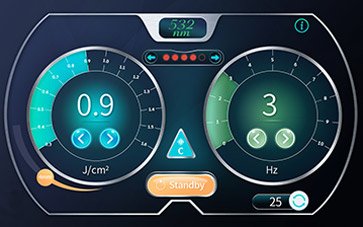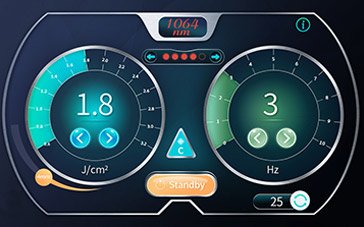TitanPico Laser Workstation is a cutting-edge Pico laser device with ultrashort pulse durations, measured in trillionths of a second. Emitting precise pulses of light, it targets tattoo pigments effectively. The intense energy and short pulses penetrate the skin, shattering pigments through selective photothermolysis. This process breaks pigments into smaller fragments, easily cleared by the body’s immune system. Unlike older lasers, Pico lasers efficiently remove a wide range of tattoo colors without damaging surrounding tissue, minimizing treatment sessions.

When the laser emits pulses at 532nm, it is selectively absorbed by the specific pigments in the tattoo.
The high-energy pulses of this wavelength break down these lighter pigments into smaller particles.
The fragmented pigments become more manageable for the body’s natural immune response to clear away over time.

This longer wavelength penetrates deeper into the skin, reaching the tattoo pigments in the dermal layer.
The energy delivered at 1064nm causes the dark pigments to heat up and shatter into tiny fragments.
These smaller particles can be gradually eliminated by the body’s immune system through the lymphatic system.
The number of sessions required for complete tattoo removal typically falls within the range of 6 to 12 appointments, although this can vary based on factors like tattoo size and color. Some liken tattoo removal to the sensation of getting a tattoo, with the process being notably shorter. If needed, a cooling anesthetic may be applied to alleviate any patient discomfort. TitanPico laser tattoo removal treatments are generally associated with minimal side effects, such as a sunburn-like sensation and temporary skin whitening. While individual experiences may differ, most patients can resume their regular activities immediately after treatment without any downtime.
Tattoos are intricate designs or patterns that are permanently etched onto the skin’s surface using pigmented inks. These permanent ink deposits are placed within the dermal layer of the skin, which is located below the outermost layer known as the epidermis. The permanence of tattoos is due to the fact that the body’s natural processes are unable to completely remove or break down the pigments.
Traditional tattoo removal methods include dermabrasion, salabrasion, and Q-switched nanosecond lasers:
Dermabrasion involves the use of a high-speed rotating device with an abrasive surface to physically remove layers of skin containing the tattoo pigments.
Salabrasion employs an abrasive substance, usually a salt-based solution, to exfoliate the skin and eliminate tattoo pigments.
Q-switched nanosecond lasers have been a significant advancement in tattoo removal. These lasers emit intense pulses of light with nanosecond durations, which target the pigments by breaking them down into smaller particles that the body’s immune system can gradually eliminate.
Drawbacks of these traditional methods include:
Pain and Discomfort: Dermabrasion and Salabrasion can be painful during and after the procedure, requiring anesthesia or pain management.
Scarring and Skin Damage: These methods often result in varying degrees of scarring, texture changes, and uneven skin tone, affecting the aesthetic outcome.
Limited Color Range: Traditional methods struggle to effectively remove a wide range of tattoo ink colors, leading to incomplete removal or faded remnants.
Extended Treatment Duration: The gradual nature of these methods often requires multiple sessions spread over an extended period, delaying the desired results.
Pico laser tattoo removal offers several distinct advantages over traditional methods.
Firstly, it provides faster results and requires fewer sessions due to its ability to break down tattoo pigments more efficiently. This means that individuals seeking tattoo removal can achieve their desired outcome in a shorter span of time.
Moreover, Pico lasers excel at addressing a broader spectrum of ink colors, including challenging ones like blues, greens, and purples. This versatility ensures that a wider range of tattoos can be effectively treated, accommodating various designs and preferences.
Another significant benefit lies in the reduced risk of scarring. Unlike dermabrasion and salabrasion, which can lead to noticeable scars and skin texture changes, Pico lasers minimize the chances of scarring. Their precise energy delivery targets only the pigments, sparing the surrounding tissue.
Lastly, it offers a decreased risk of hyperpigmentation, where the treated area either becomes lighter or darker than the surrounding skin. By minimizing heat dispersion to adjacent tissues, Pico lasers safeguard against these pigment-related complications, enhancing the overall safety and cosmetic outcomes of the tattoo removal process.
TitanPico operates at a remarkable speed, delivering results three times faster than its predecessors. Although outcomes vary from person to person, we can significantly reduce the required number of sessions from the previous 15-20 down to just 5-10. This advanced laser technology minimizes heat damage, reducing the risk of scarring, and even enhances skin texture by activating the body’s immune system. Notably, TitanPico can eliminate smaller tattoos in less than a minute.


“I recently tried the TitanPico laser tattoo removal, and I couldn’t be happier with the results. The process was quicker and less painful than I anticipated. It was incredible how the dual wavelengths precisely targeted different ink colors, making it ideal for my multicolored tattoo. After just a few sessions, I noticed significant fading, and some smaller tattoos were gone in minutes. Plus, the reduced risk of scarring and the improvement in skin texture were impressive. The efficiency of TitanPico saved me time and money compared to traditional methods. I highly recommend it to anyone looking to remove their tattoos with minimal discomfort and great results.”
[1] Hsu, V. M., Aldahan, A. S., Mlacker, S., Shah, V. V., & Nouri, K. (2016). The picosecond laser for tattoo removal. Lasers in medical science, 31, 1733-1737.
[2] Peach, A. H. S., Thomas, K., & Kenealy, J. (1999). Colour shift following tattoo removal with Q-switched Nd-YAG laser (1064/532). British journal of plastic surgery, 52(6), 482-487.
[3] Adatto, M. A., Amir, R., Bhawalkar, J., Sierra, R., Bankowski, R., Rozen, D., … & Lapidoth, M. (2017). New and advanced picosecond lasers for tattoo removal. In Diagnosis and therapy of tattoo complications (Vol. 52, pp. 113-123). Karger Publishers.
[4] Choi, M. S., Seo, H. S., Kim, J. G., Choe, S. J., Park, B. C., Kim, M. H., & Hong, S. P. (2018). Effects of picosecond laser on the multi-colored tattoo removal using Hartley guinea pig: A preliminary study. PLoS One, 13(9), e0203370.
[5] Sirithanabadeekul, P., Vongchansathapat, P., Sutthipisal, N., Thanasarnaksorn, W., & Suwanchinda, A. (2022). Outcomes of 1064‐nm picosecond laser alone and in combination with fractional 1064‐nm picosecond laser in tattoo removal. Journal of Cosmetic Dermatology, 21(7), 2832-2839.
[6] Hernandez, L., Mohsin, N., Frech, F. S., Dreyfuss, I., Vander Does, A., & Nouri, K. (2022). Laser tattoo removal: laser principles and an updated guide for clinicians. Lasers in medical science, 37(6), 2581-2587.
[7] Reiter, O., Atzmony, L., Akerman, L., Levi, A., Kershenovich, R., Lapidoth, M., & Mimouni, D. (2016). Picosecond lasers for tattoo removal: a systematic review. Lasers in medical science, 31, 1397-1405.
Clearance of Yellow Tattoo Ink with a Novel 532-nm Picosecond Laser
https://onlinelibrary.wiley.com/doi/abs/10.1002/lsm.22354
Safety and Efficacy of Tattoo Removal Using a Dual-Wavelength 1064/532-nm Picosecond Laser in Patients with Fitzpatrick Skin Type III and IV
https://onlinelibrary.wiley.com/doi/abs/10.1002/lsm.23333
Picosecond Q-Switched 1064/532 nm Laser in Tattoo Removal: Our Single Center Experience
https://www.mdpi.com/2076-3417/11/20/9712